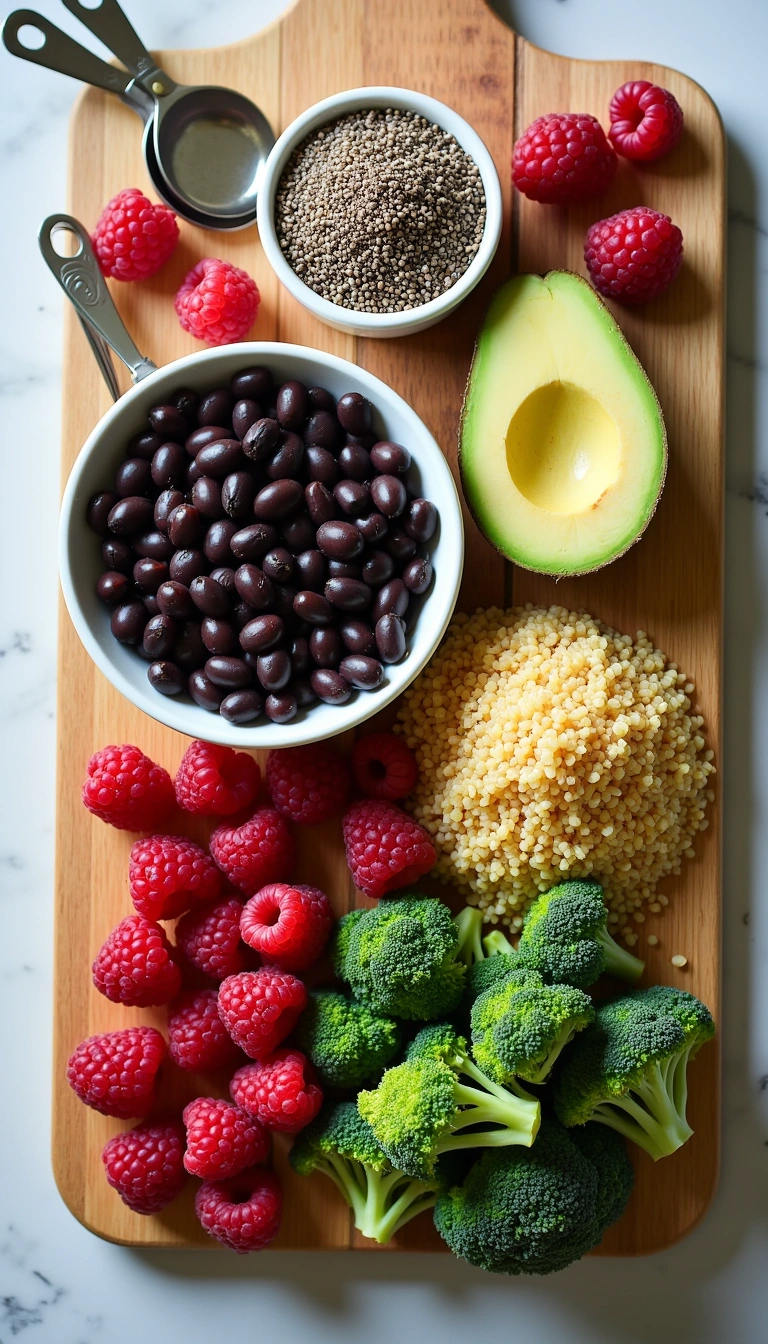High fiber foods for diabetics can be your secret weapon in the battle against unstable blood sugar levels. These nutritional powerhouses work like tiny sponges in your digestive system. They slow down sugar absorption and keep your glucose levels steady. Think of them as your body’s natural blood sugar regulators.
Managing diabetes doesn’t mean you have to sacrifice taste or variety in your meals. The right high-fiber choices can actually make your diet more interesting while helping you maintain better glucose control. You’ll discover that these foods not only support your blood sugar goals but also keep you feeling full and satisfied longer.
1. Black Beans Pack a Double Punch

Black beans deliver an impressive 15 grams of fiber per cup, making them one of the most powerful foods for blood sugar management. The soluble fiber in black beans forms a gel-like substance in your stomach that slows glucose absorption. This means your blood sugar rises more gradually after meals instead of spiking dramatically.
A half-cup serving of black beans has the same fiber content as three slices of whole wheat bread. You can easily add them to salads, soups, or make them the star of a hearty burrito bowl. Their protein content also helps stabilize blood sugar levels throughout the day.
Tip: Rinse canned black beans to reduce sodium content by up to 40% while keeping all the fiber benefits.
2. Avocados Offer Healthy Fats Plus Fiber
One medium avocado contains about 10 grams of fiber, mostly the soluble type that’s especially beneficial for blood sugar control. The combination of fiber and healthy monounsaturated fats helps slow digestion and prevents rapid glucose spikes. This creamy fruit also provides potassium, which supports heart health—important for people with diabetes.
Research shows that people who eat avocados regularly have better insulin sensitivity compared to those who don’t. You can mash half an avocado on whole grain toast or add slices to your morning omelet. The healthy fats also help your body absorb fat-soluble vitamins from other foods.
Takeaway: Replace butter or mayo with mashed avocado to boost fiber intake while reducing saturated fat.
3. Brussels Sprouts Deliver Surprising Benefits
These mini cabbages pack 4 grams of fiber per cup and contain compounds that may help improve insulin function. Brussels sprouts are rich in alpha-lipoic acid, an antioxidant that research suggests can enhance glucose uptake by cells. The fiber content helps slow carbohydrate absorption, preventing blood sugar roller coasters.
Roasting Brussels sprouts with a drizzle of olive oil transforms their sometimes bitter taste into something deliciously nutty and caramelized. A study found that people who ate cruciferous vegetables like Brussels sprouts had a 14% lower risk of developing type 2 diabetes. They’re also loaded with vitamin K and vitamin C.
Tip: Cut Brussels sprouts in half before roasting to ensure even cooking and better caramelization.
4. Chia Seeds Create Natural Slow-Release Energy
Just two tablespoons of chia seeds provide 10 grams of fiber—that’s about one-third of your daily needs. When mixed with liquid, chia seeds form a gel that significantly slows down how quickly your body processes carbohydrates. This gel-forming action happens in your stomach, creating a barrier that moderates glucose absorption.
Chia seeds can absorb up to 12 times their weight in water, which means they help you feel full longer. You can stir them into yogurt, blend them into smoothies, or make chia pudding for a diabetes-friendly dessert. Unlike flax seeds, you don’t need to grind chia seeds to get their nutritional benefits.
Takeaway: Soak chia seeds for 15 minutes before eating to activate their gel-forming properties and maximize blood sugar benefits.
5. Artichokes Are Fiber Superstars
One medium artichoke delivers a whopping 10 grams of fiber, making it one of the highest-fiber vegetables available. The specific type of fiber in artichokes, called inulin, acts as a prebiotic that feeds beneficial gut bacteria. A healthy gut microbiome is increasingly linked to better blood sugar control and improved insulin sensitivity.
Artichokes also contain cynarin, a compound that may help regenerate liver tissue and support healthy cholesterol levels. You can steam whole artichokes and dip the leaves in lemon juice, or add artichoke hearts to salads and pasta dishes. Frozen artichoke hearts are just as nutritious as fresh ones and much more convenient.
Tip: Look for artichokes with tightly closed leaves and a bright green color for the best fiber content and freshness.
6. Raspberries Satisfy Your Sweet Tooth Safely
Raspberries contain 8 grams of fiber per cup while being relatively low in sugar compared to other fruits. The fiber helps offset the natural fruit sugars, resulting in a lower glycemic impact. These berries also contain anthocyanins, powerful antioxidants that research suggests may improve insulin sensitivity and reduce inflammation.
Fresh or frozen raspberries work equally well for blood sugar management. You can add them to plain Greek yogurt, toss them in salads, or eat them as a standalone snack. Studies show that people who eat berries regularly have better long-term blood sugar control compared to those who avoid fruit altogether.
Takeaway: Choose raspberries over higher-sugar fruits like grapes or pineapple to satisfy cravings while supporting blood sugar goals.
7. Lentils Provide Plant-Based Protein and Fiber
Red, green, or brown lentils all deliver about 15 grams of fiber per cooked cup, along with 18 grams of protein. This combination makes lentils incredibly effective at preventing blood sugar spikes after meals. The protein helps slow digestion while the fiber creates a physical barrier to rapid glucose absorption.
Lentils have a low glycemic index of just 25, meaning they cause minimal blood sugar elevation. You can use them in soups, curries, or as a meat substitute in tacos and sloppy joes. Red lentils cook faster than other varieties and work well in Indian-inspired dishes with turmeric and other blood sugar-supporting spices.
Tip: Cook a large batch of lentils on Sunday and use them throughout the week in different meals to save time.
8. Broccoli Offers More Than Just Vitamins
One cup of cooked broccoli provides 5 grams of fiber plus a compound called sulforaphane that may help improve blood sugar control. Sulforaphane appears to help reduce glucose production in the liver and improve insulin sensitivity in muscle cells. The fiber in broccoli is mostly insoluble, which adds bulk to meals and helps you feel satisfied.
Broccoli is incredibly versatile and retains its fiber content whether you eat it raw, steamed, or roasted. Research indicates that people who eat cruciferous vegetables like broccoli at least four times per week have better HbA1c levels. You can add broccoli florets to stir-fries, casseroles, or eat them raw with hummus.
Takeaway: Don’t overcook broccoli—steam for just 3-4 minutes to preserve both fiber content and blood sugar-supporting compounds.
9. Quinoa Replaces High-Glycemic Grains
This ancient grain provides 5 grams of fiber per cooked cup and has a lower glycemic index than white rice or pasta. Quinoa is technically a seed, not a grain, and contains all nine essential amino acids your body needs. The fiber and protein combination helps stabilize blood sugar levels for hours after eating.
Unlike many grains, quinoa doesn’t cause significant blood sugar spikes in most people with diabetes. You can use it as a base for grain bowls, add it to soups, or use quinoa flour in baking. Quinoa also provides magnesium, a mineral that many people with diabetes are deficient in and which plays a role in glucose metabolism.
Tip: Rinse quinoa before cooking to remove its natural bitter coating and improve the taste.
10. Apples With Skin Keep Blood Sugar Steady
A medium apple with skin contains 4 grams of fiber, with most of it concentrated in the peel. The pectin fiber in apples specifically helps slow glucose absorption and may even help lower cholesterol levels. Apples also contain polyphenols that research suggests can help improve insulin sensitivity over time.
The key is eating the whole apple rather than drinking apple juice, which lacks fiber and causes rapid blood sugar spikes. Pairing apple slices with a protein source like almond butter further slows sugar absorption. Green apples tend to have slightly less sugar than red varieties, making them an even better choice for blood sugar management.
Takeaway: Always eat apples with the skin on and pair them with a protein or healthy fat to maximize blood sugar benefits.
11. Sweet Potatoes Beat Regular Potatoes
One medium baked sweet potato with skin provides 4 grams of fiber and has a lower glycemic index than regular white potatoes. Sweet potatoes contain a specific type of fiber that may help improve insulin sensitivity. They’re also rich in beta-carotene, which converts to vitamin A and supports overall health.
The orange flesh indicates high levels of carotenoids, antioxidants that may help reduce diabetes-related complications. You can bake, roast, or even spiralize sweet potatoes as a pasta alternative. Studies show that purple sweet potatoes may be even better for blood sugar control, though they’re harder to find in most grocery stores.
Tip: Leave the skin on sweet potatoes when cooking to maximize fiber intake and add extra nutrients.
12. Flaxseeds Provide Omega-3s and Fiber
Two tablespoons of ground flaxseeds deliver 4 grams of fiber plus omega-3 fatty acids that help reduce inflammation. The lignans in flaxseeds may help improve insulin sensitivity and support hormone balance. Ground flaxseeds are better absorbed than whole ones, so your body can actually use all the beneficial compounds.
Flaxseeds have a mild, nutty flavor that works well in smoothies, oatmeal, or sprinkled on salads. The combination of fiber, healthy fats, and protein makes flaxseeds particularly effective at preventing post-meal blood sugar spikes. Store ground flaxseeds in the refrigerator to prevent the oils from going rancid.
Takeaway: Buy whole flaxseeds and grind them fresh in a coffee grinder to get maximum nutritional benefits. Making high-fiber foods a regular part of your diabetes management plan can significantly improve your blood sugar control. Start by adding one or two of these options to your meals each day. Your taste buds and your glucose meter will thank you for these delicious, diabetes-friendly choices.

Lifebing is driven by an unrelenting passion for promoting health and well-being, our team is wholly committed to curating exceptional content and immersive experiences.
